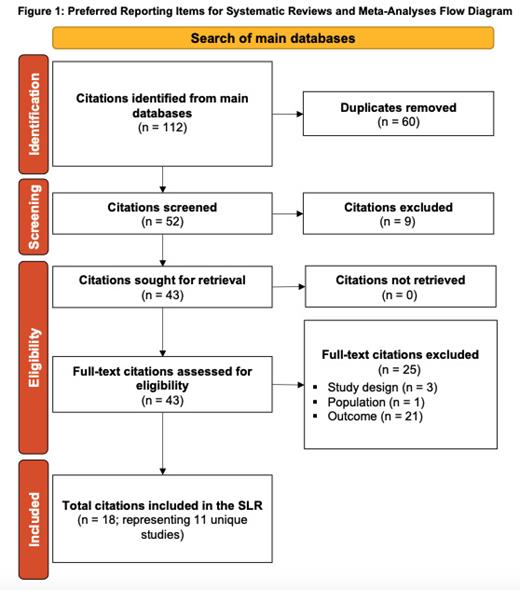Introduction: Fatigue is a common symptom in patients living with SCD, with 84% reporting its presence within the past year in a recent large multinational survey. Although the exact pathophysiology resulting in fatigue is not fully understood, it is hypothesized that it may be secondary to the underlying abnormal processes of the sickle red blood cells including ongoing hemolysis, vaso-occlusive events, pain, and anemia. PROMIS Fatigue is a widely used, validated tool that utilizes a T-score metric, where 50 represents the average in the general population and scores above/below show worse/better relative outcomes. In this study, the objectives were to conduct an SLR of published evidence to understand 1) the utilization of PROMIS Fatigue in studies of SCD populations, 2) the PROMIS Fatigue scores reported in these studies, and 3) to characterize the estimates of fatigue across the full evidence base in order to assess the usefulness of the tool as a measure of fatigue in this population.
Methods: Studies eligible for inclusion in the SLR were clinical trials or observational studies that featured adult and/or pediatric patients with a confirmed diagnosis of SCD and reported PROMIS Fatigue scores (note studies that were not published in the English language were excluded). Structured searches of PubMed, the Excerpta Medica dataBASE, and Cochrane Library (up to February 2022) were conducted. Using the Covidence platform, one reviewer evaluated the eligibility of articles resulting from the database searches, with decisions validated by another more senior reviewer. A similar process was followed for data extraction, whereby data were extracted on study, intervention, and patient characteristics, as well as PROMIS Fatigue scores (both pre and post treatment in interventional studies).
Results: The database searches yielded 112 citations, 43 of which were included for full-text screening. Of these, 25 were excluded; one due to population ineligibility, three due to ineligible study designs, and 21 due to not reporting PROMIS Fatigue scores. This resulted in 18 citations, corresponding to 11 unique studies, included in the SLR ( Figure 1). Two studies were randomized controlled trials (RCTs), one was a secondary analysis of patients from a previous RCT, two were non-randomized trials, and the remaining six were cross-sectional observational studies. Although all included studies happened to be conducted in the United States, a high degree of heterogeneity was observed across populations; for example, age groupings were inconsistently defined and treatment interventions differed across studies (e.g. four reported patients received routine blood transfusion; eight reported patients received hydroxyurea). Of note, variation was observed in the specific PROMIS instrument administered (e.g., PROMIS and [pediatric] short forms), as well as schedules of assessment (12 weeks to 24 months follow up, with varying frequency of assessment in between). Mean/median PROMIS Fatigue scores for patients with SCD were generally higher than that of the general population (PROMIS fatigue T-score = 50), although still within one standard deviation (10). Mean/median estimates at baseline ranged from 51.7-55.7/52.8-53.7 in the five interventional studies. The corresponding range of mean estimates from the cross-sectional studies was 46.7-56.3 (one study reported a mean of 19.82, assumed to be the untransformed value), with the two studies with better scores than the general population being conducted in younger populations. The correlation between various factors and PROMIS Fatigue scores was assessed, with pain shown to be associated with worse scores.
Conclusion/Summary: Despite the burden of fatigue in people living with SCD, the results from this SLR show that tools such as PROMIS Fatigue are infrequently used and, when used, are implemented inconsistently. The available PROMIS Fatigue scores in patients with SCD were marginally worse than the general population; however, the high degree of heterogeneity makes it challenging to draw strong conclusions from the available data. Further research is required to fully quantify fatigue in patients living with SCD and particular attention should be paid to consistently implementing and optimizing patient-reported outcomes measurement tools, such as PROMIS Fatigue, as well as ensuring potential drivers of changes are fully captured.
Disclosures
Batt:Takeda: Consultancy; Forma Therapeutics, a Novo Nordisk Company: Consultancy; Novo Nordisk Inc: Consultancy; Bayer: Consultancy; Janssen: Consultancy, Current equity holder in publicly-traded company; Pfizer: Consultancy; Sanofi: Current equity holder in publicly-traded company; Merck: Current equity holder in publicly-traded company. Albrecht:Novo Nordisk Inc: Current Employment. Wilson:Forma Therapeutics, a Novo Nordisk Company: Current Employment. du Moulin:Novo Nordisk Inc: Current Employment.


This feature is available to Subscribers Only
Sign In or Create an Account Close Modal